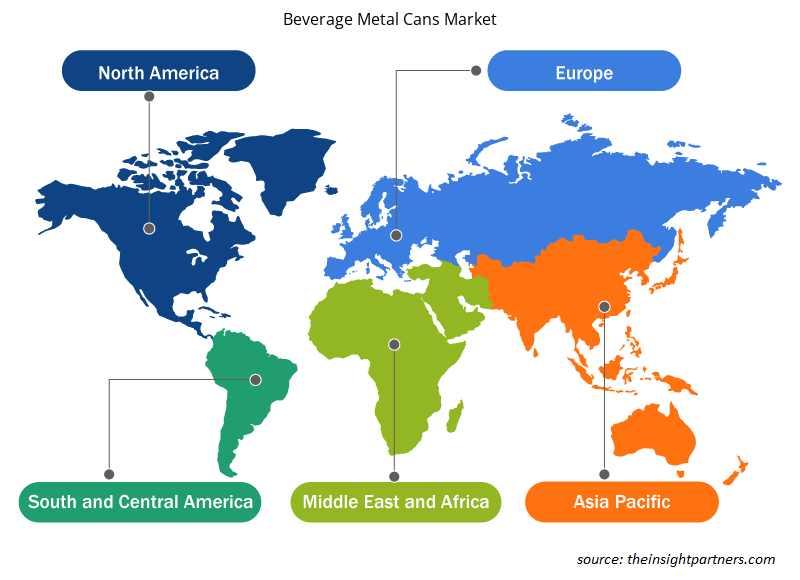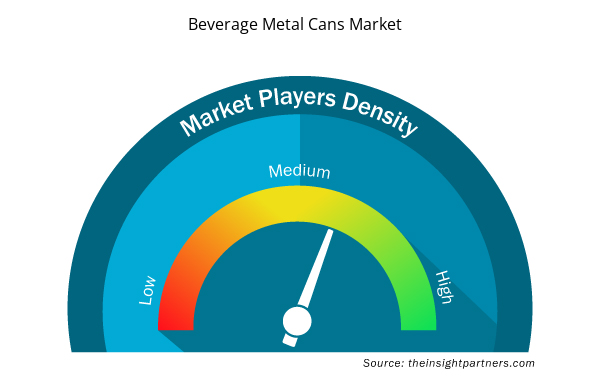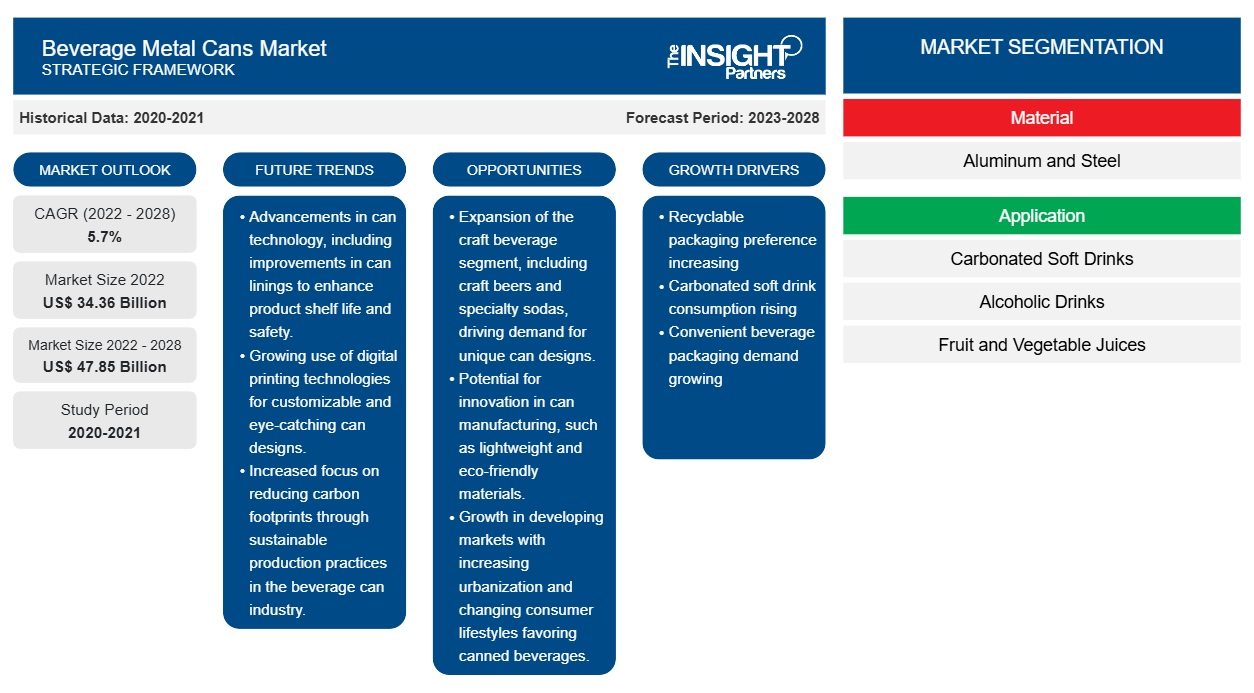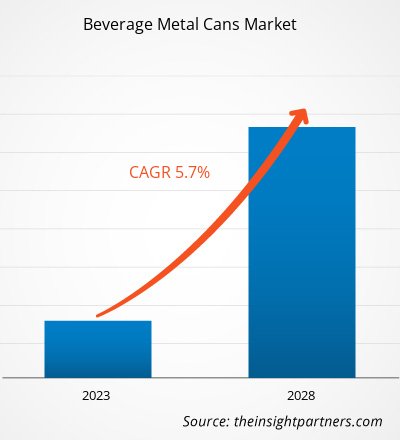饮料金属罐市场规模预计将从 2022 年的 343.6314 亿美元增至 2028 年的 478.5242 亿美元;预计 2022-2028 年期间的复合年增长率为 5.7%
市场的增长归因于全球迅速增长的环保意识。因此,政府实施了各种法规,用可回收和环保的金属或玻璃包装替代塑料包装。饮料金属罐的总体碳足迹低于塑料包装,因为原材料可以从回收材料中获得,不需要原始原材料,而不像塑料。此外,金属包装经久耐用,被认为对食品和饮料行业的应用是安全的。2021年,北美占据了全球饮料金属罐市场
的最大份额。然而,预计在预测期内,亚太地区的市场复合年增长率最高。亚太地区的市场分为中国、印度、日本、韩国和澳大利亚。韩国、中国和日本等国家是食品和饮料的主要市场。该地区也是众多食品和饮料制造商的所在地,由于国内对包装饮料的需求增加,这些制造商的数量正在增长。预测期内,亚太地区饮料产量的增加和对可回收包装材料的日益偏好将有助于该地区市场的增长。
定制此报告以满足您的需求
您可以免费定制任何报告,包括本报告的部分内容、国家级分析、Excel 数据包,以及为初创企业和大学提供优惠和折扣
- 获取此报告的关键市场趋势。这个免费样品将包括数据分析,从市场趋势到估计和预测。
COVID-19 疫情对饮料金属罐市场的影响
由于不同地区的封锁时间延长、制造单位停工、旅行、国际贸易和供应链受限以及原材料供应短缺,COVID-19 疫情严重影响了制造业的运营效率。由于制造单位停工、原材料价格上涨、劳动力短缺、供应链中断和金融不稳定,疫情对市场产生了负面影响。此外,由于 COVID-19 疫情导致的经济放缓,食品和饮料行业受到干扰,阻碍了市场的增长。然而,随着各国放松先前实施的限制,企业正在取得进展。此外,各国政府推出 COVID-19 疫苗进一步缓解了这种情况,导致全球商业活动增加。此外,各国政府正计划开发现代化和技术先进的基础设施,以减轻疫情对经济的影响。在封锁期间,消费者购买了大量包装食品和饮料,而不是食品服务产品。因此,尽管受到 COVID-19 疫情的负面影响,但预计未来几年饮料金属罐市场将实现显着增长。
市场洞察
碳酸软饮料消费量高
碳酸软饮料是为了满足消费者的口味和风味偏好而生产的,最近这些产品被创造出来作为注重健康的消费者的功能性饮料。由于制造商不断推出新口味, 碳酸软饮料
在消费者中越来越受欢迎。对清洁标签、无麸质、低热量和低碳水化合物产品的需求增加,也增加了对碳酸软饮料的需求。金属罐被广泛用作碳酸软饮料的包装材料。消费者希望新推出的软饮料不含长期损害健康的成分,并通过精心挑选的成分促进身心健康。低糖软饮料和具有缓解压力效果的产品预计将继续受到消费者的欢迎。随着功能性饮料行业的扩张和消费者健康意识的增强,健康饮料的趋势越来越受欢迎。沃尔玛和便利店等市场上低热量或零热量饮料的普及推动了碳酸软饮料的消费。因此,碳酸软饮料的需求和消费增加推动了饮料金属罐市场的增长。
应用程序洞察
根据应用,全球饮料金属罐市场细分为碳酸软饮料、酒精饮料、果蔬汁等。2021 年,酒精饮料部分占据了最大的市场份额。酒精饮料由浆果、水果、谷物和其他成分(如植物汁液、块茎、蜂蜜和牛奶)中的糖发酵而成。它们可以蒸馏,将原来的水状液体转化为酒精浓度相当高的液体。此外,对便携式容器的需求增加推动了酒精饮料部分的增长。由于全球消费者工作习惯的改变,罐装酒精饮料市场可能会增长。罐装有助于保持饮料中的纤维含量,在不影响质量的情况下延长保质期,使其成为生产具有软功能优势的饮料的饮料制造商的首选。
Ball Corporation;Crown Holdings, Inc.;Ardagh Group SA;CANPACK;Orora Packaging Australia Pty Ltd;Amcor plc;Silgan Containers LLC;ZI Industries Limited;SHOWA DENKO KK;以及 Envases Group 都是饮料金属罐市场的参与者。这些公司为市场提供了广泛的产品组合。这些公司在发展中地区都有业务,这为饮料金属罐市场的增长提供了有利可图的机会。市场参与者正在开发高质量和创新的产品以满足客户的要求。
饮料金属罐市场区域洞察
Insight Partners 的分析师已详尽解释了预测期内影响饮料金属罐市场的区域趋势和因素。本节还讨论了北美、欧洲、亚太地区、中东和非洲以及南美和中美洲的饮料金属罐市场细分和地理位置。

- 获取饮料金属罐市场的区域特定数据
饮料金属罐市场报告范围
| 报告属性 | 细节 |
|---|---|
| 2022 年市场规模 | 343.6亿美元 |
| 2028 年市场规模 | 478.5亿美元 |
| 全球复合年增长率(2022 - 2028) | 5.7% |
| 史料 | 2020-2021 |
| 预测期 | 2023-2028 |
| 涵盖的领域 | 按材质
|
| 覆盖地区和国家 | 北美
|
| 市场领导者和主要公司简介 |
|
饮料金属罐市场参与者密度:了解其对业务动态的影响
饮料金属罐市场正在快速增长,这得益于终端用户需求的不断增长,而这些需求又源于消费者偏好的不断变化、技术进步以及对产品优势的认识不断提高等因素。随着需求的增加,企业正在扩大其产品范围,进行创新以满足消费者的需求,并利用新兴趋势,从而进一步推动市场增长。
市场参与者密度是指在特定市场或行业内运营的企业或公司的分布情况。它表明在给定市场空间中,相对于其规模或总市场价值,有多少竞争对手(市场参与者)存在。
在饮料金属罐市场运营的主要公司有:
- 鲍尔公司
- 皇冠控股公司
- 阿达集团
- 加拿大包装
- Orora 包装澳大利亚有限公司
免责声明:上面列出的公司没有按照任何特定顺序排列。

- 了解饮料金属罐市场的主要参与者概况
报告亮点
- 饮料金属罐市场的渐进式行业趋势有助于参与者制定有效的长期战略
- 发达市场和发展中市场采用的业务增长战略
- 2019年至2028年饮料金属罐市场定量分析
- 全球饮料金属罐需求量估计
- 波特的五力分析说明了行业中买家和供应商的效力
- 了解竞争市场状况的最新发展
- 市场趋势和前景以及推动和抑制饮料金属罐市场增长的因素
- 通过强调支撑商业利益的市场策略来协助决策过程,从而促进市场增长
- 饮料金属罐市场规模在各个节点的大小
- 市场详细概述和细分,以及饮料金属罐行业动态
- 各地区饮料金属罐市场规模及增长潜力巨大
“2028 年全球饮料金属罐市场分析”是一项针对化学品和材料行业的专业深入研究,特别关注全球饮料金属罐市场趋势分析。该报告旨在提供市场概述和详细的市场细分。饮料金属罐市场根据材料、应用和地理位置进行细分。按材料,市场分为铝和钢。按应用,饮料金属罐市场分为碳酸软饮料、酒精饮料、果汁和蔬菜汁等。按地理位置,市场大致分为北美、欧洲、亚太地区 (APAC)、中东和非洲 (MEA) 以及南美洲和中美洲。
公司简介
- 鲍尔公司
- 皇冠控股公司
- 阿达集团
- 加拿大包装
- Orora 包装澳大利亚有限公司
- 安姆科公司
- Silgan Containers LLC
- ZI 实业有限公司
- 日本昭和电工株式会社
- 恩瓦斯集团
- 历史分析(2 年)、基准年、预测(7 年)及复合年增长率
- PEST 和 SWOT 分析
- 市场规模价值/数量 - 全球、区域、国家
- 行业和竞争格局
- Excel 数据集



Report Coverage
Revenue forecast, Company Analysis, Industry landscape, Growth factors, and Trends

Segment Covered
This text is related
to segments covered.

Regional Scope
North America, Europe, Asia Pacific, Middle East & Africa, South & Central America

Country Scope
This text is related
to country scope.
常见问题
Increased worldwide beverage consumption and a spike in demand for sustainable packaging alternatives have resulted in increased use of aluminum cans. Furthermore, these cans can be personalised in terms of colors and 3D printing, as well as embossed, making them more attractive to buyers. These factors are boosting the growth of the beverage metal cans market.
Based on material, the aluminum segment is expected to be the fastest-growing segment during the forecast period. Recyclability of aluminium cans is the major factor propelling the demand for aluminum cans.
In 2021, the alcoholic drinks segment held the largest market share. In 2021, the demand for portable containers that are less brittle than glass was high, which led the canned alcoholic beverage industry forward.
In 2021, the aluminum segment held the largest market share. Environmental groups' initiatives and public awareness about the environment have increased awareness among users worldwide. Consumers demand packaging products that have little to zero environmental impact. Consumers are increasingly rejecting plastic, while demand for recycled items is increasing. As a result, metal packed items, such as aluminium cans, held the largest market share in 2021.
The major players operating in the beverage metal cans market are Ball Corporation, Crown Holdings, Inc., Ardagh Group S.A., Canpack, Orora Packaging Australia Pty Ltd., Amcor plc., Silgan Containers LLC, GZI Industries Limited, Showa Denko K.K., and Envases Group.
In 2021, North America accounted for the largest global beverage metal cans market share. Metal cans are the most often used container for beverages. Metal packaging is the most noticeable packaging trend in canned wine, cocktails, hard beverages, and soft drinks. They have traditionally been used for alcoholic drinks such as beer, whereas other types of liquor, such as wine, which has traditionally been served in glass bottles, are increasingly adopting metal cans to provide single-serving options.
Trends and growth analysis reports related to Chemicals and Materials : READ MORE..
The List of Companies - Beverage Metal Cans Market
- Ball Corporation
- Crown Holdings, Inc.
- Ardagh Group S.A.
- CANPACK
- Orora Packaging Australia Pty Ltd
- Amcor plc
- Silgan Containers LLC
- GZI Industries Limited
- Showa Denko K.K.
- Envases Group
The Insight Partners performs research in 4 major stages: Data Collection & Secondary Research, Primary Research, Data Analysis and Data Triangulation & Final Review.
- Data Collection and Secondary Research:
As a market research and consulting firm operating from a decade, we have published and advised several client across the globe. First step for any study will start with an assessment of currently available data and insights from existing reports. Further, historical and current market information is collected from Investor Presentations, Annual Reports, SEC Filings, etc., and other information related to company’s performance and market positioning are gathered from Paid Databases (Factiva, Hoovers, and Reuters) and various other publications available in public domain.
Several associations trade associates, technical forums, institutes, societies and organization are accessed to gain technical as well as market related insights through their publications such as research papers, blogs and press releases related to the studies are referred to get cues about the market. Further, white papers, journals, magazines, and other news articles published in last 3 years are scrutinized and analyzed to understand the current market trends.
- Primary Research:
The primarily interview analysis comprise of data obtained from industry participants interview and answers to survey questions gathered by in-house primary team.
For primary research, interviews are conducted with industry experts/CEOs/Marketing Managers/VPs/Subject Matter Experts from both demand and supply side to get a 360-degree view of the market. The primary team conducts several interviews based on the complexity of the markets to understand the various market trends and dynamics which makes research more credible and precise.
A typical research interview fulfils the following functions:
- Provides first-hand information on the market size, market trends, growth trends, competitive landscape, and outlook
- Validates and strengthens in-house secondary research findings
- Develops the analysis team’s expertise and market understanding
Primary research involves email interactions and telephone interviews for each market, category, segment, and sub-segment across geographies. The participants who typically take part in such a process include, but are not limited to:
- Industry participants: VPs, business development managers, market intelligence managers and national sales managers
- Outside experts: Valuation experts, research analysts and key opinion leaders specializing in the electronics and semiconductor industry.
Below is the breakup of our primary respondents by company, designation, and region:

Once we receive the confirmation from primary research sources or primary respondents, we finalize the base year market estimation and forecast the data as per the macroeconomic and microeconomic factors assessed during data collection.
- Data Analysis:
Once data is validated through both secondary as well as primary respondents, we finalize the market estimations by hypothesis formulation and factor analysis at regional and country level.
- Macro-Economic Factor Analysis:
We analyse macroeconomic indicators such the gross domestic product (GDP), increase in the demand for goods and services across industries, technological advancement, regional economic growth, governmental policies, the influence of COVID-19, PEST analysis, and other aspects. This analysis aids in setting benchmarks for various nations/regions and approximating market splits. Additionally, the general trend of the aforementioned components aid in determining the market's development possibilities.
- Country Level Data:
Various factors that are especially aligned to the country are taken into account to determine the market size for a certain area and country, including the presence of vendors, such as headquarters and offices, the country's GDP, demand patterns, and industry growth. To comprehend the market dynamics for the nation, a number of growth variables, inhibitors, application areas, and current market trends are researched. The aforementioned elements aid in determining the country's overall market's growth potential.
- Company Profile:
The “Table of Contents” is formulated by listing and analyzing more than 25 - 30 companies operating in the market ecosystem across geographies. However, we profile only 10 companies as a standard practice in our syndicate reports. These 10 companies comprise leading, emerging, and regional players. Nonetheless, our analysis is not restricted to the 10 listed companies, we also analyze other companies present in the market to develop a holistic view and understand the prevailing trends. The “Company Profiles” section in the report covers key facts, business description, products & services, financial information, SWOT analysis, and key developments. The financial information presented is extracted from the annual reports and official documents of the publicly listed companies. Upon collecting the information for the sections of respective companies, we verify them via various primary sources and then compile the data in respective company profiles. The company level information helps us in deriving the base number as well as in forecasting the market size.
- Developing Base Number:
Aggregation of sales statistics (2020-2022) and macro-economic factor, and other secondary and primary research insights are utilized to arrive at base number and related market shares for 2022. The data gaps are identified in this step and relevant market data is analyzed, collected from paid primary interviews or databases. On finalizing the base year market size, forecasts are developed on the basis of macro-economic, industry and market growth factors and company level analysis.
- Data Triangulation and Final Review:
The market findings and base year market size calculations are validated from supply as well as demand side. Demand side validations are based on macro-economic factor analysis and benchmarks for respective regions and countries. In case of supply side validations, revenues of major companies are estimated (in case not available) based on industry benchmark, approximate number of employees, product portfolio, and primary interviews revenues are gathered. Further revenue from target product/service segment is assessed to avoid overshooting of market statistics. In case of heavy deviations between supply and demand side values, all thes steps are repeated to achieve synchronization.
We follow an iterative model, wherein we share our research findings with Subject Matter Experts (SME’s) and Key Opinion Leaders (KOLs) until consensus view of the market is not formulated – this model negates any drastic deviation in the opinions of experts. Only validated and universally acceptable research findings are quoted in our reports.
We have important check points that we use to validate our research findings – which we call – data triangulation, where we validate the information, we generate from secondary sources with primary interviews and then we re-validate with our internal data bases and Subject matter experts. This comprehensive model enables us to deliver high quality, reliable data in shortest possible time.


 获取此报告的免费样本
获取此报告的免费样本